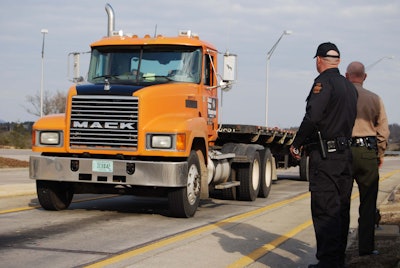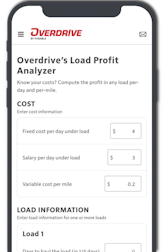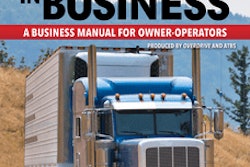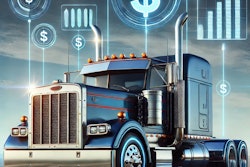 On-site in 2011 for the final day of a Wireless Roadside Inspection test project, also the day FMCSA proposed to mandate electronic onboard recorders for hours of service compliance.
On-site in 2011 for the final day of a Wireless Roadside Inspection test project, also the day FMCSA proposed to mandate electronic onboard recorders for hours of service compliance.Longtime readers may be able to search back in that data bank known as the brain and recall that, in January 2011, as I worked on a series of initial Overdrive features about the then little infant of a program still called CSA 2010 (if my own memory serves and they in fact hadn’t yet dropped the 2010, though I may be wrong), I visited the Greene County, Tenn., scales on I-81 to talk Wireless Roadside Inspection with a state police lieutenant and several inspectors there. (Or, of course, you could click through this link to check out the story I wrote that day, stopping off at a coffeehouse on the way home to Nashville.) It was a memorable day — sometime during the several-hour drive out to the scale I picked up an email from the Federal Motor Carrier Safety Administration’s public affairs office that the agency was officially proposing to mandate electronic onboard recorders for hours-of-service compliance for the entire industry. Two years later, they’re still in hot pursuit of such a mandate, now with the added support of Congress after the MAP-21 highway bill and time spent addressing the driver-harrassment issue that got the limited mandate thrown out two years ago.
EOBRs are an important part of Wireless Roadside Inspection technology, as their presence in trucks would enable carriers and owner-operators to automatically transmit driver-hours status to inspectors, thus logging any violations or evidence of a clean look in the federal inspection database. Electronic logs were also integral to the similar e-Inspection commercial technology demonstrated by the Drivewyze company with Zonar, PeopleNet and XRS among state partners just last week. I spoke with Drivewyze President Brian Heath following the demonstration about what exactly the company was attempting to show with the demonstration, and what he had to say was interesting in light of FMCSA’s long research-and-design pursuit of Wireless Roadside Inspection technology.

Heath described the demonstration as showing that their e-Inspection process could, with relatively little further investment on the part of federal, state and local governments, allow carriers running EOBRs to opt in to a service that virtually automates what amounts to a CVSA Level 3 driver inspection, down to populating the form required to upload it to the FMCSA’s Motor Carrier Management and Information System (MCMIS) database, where theoretically it could then contribute to the carrier’s CSA profile. “It’s a fantastic opportunity to kill two birds with one stone,” Heath says. “The CSA program has a data sufficiency problem – only a small percentage of carriers have enough data,” as we well know, to populate the Safety Measurement System BASICs with a percentile ranking, or “score.”
Heath adds, “If you could automatically start feeding your CSA profile based on real-time information, you could really help FMCSA out with its data-sufficiency issues.”
And potentially help your own scores, such as they may exist. As we showed in the CSA’s Data Trail series, independent owner-operators with their own carrier authority are the least likely group of carriers to see actual percentile rankings in their CSA profiles, given the way the system works today. Only 14 percent of active owner-operators showed any score whatsoever in an SMS category (compare that to nearly 100 percent of large carriers being covered). However, independents do happen to be the most frequently inspected, measured per-truck, and owner-operators unlucky enough to show a score are very likely to be well above the intervention, or “alert,” threshold, marking them for further scrutiny. If an e-Inspection or Wireless Roadside Inspection comes to fruition, those weigh station/inspection stops could be further reduced, and it could be a great tool for those with high scores to log more clean inspections, or for carriers without sufficient data (which can also be a problem in dealings with some brokers and shippers) to populate BASICs to get enough inspections to show a very low score. That’s theoretical at this point, of course, and would be dependent on what kind of credit FMCSA would be giving for such wireless inspections.
Heath notes that state agencies are on-board with offering carriers and drivers incentives for sharing more information with inspectors. With Drivewyze’s PreClear bypass service, he says, “the state agencies are doing their part — if you’ve [opted to share your CDL info with inspectors, they say], ‘I’ll give you a boost in your bypass rate.’ But the federal government plays a big part here — in exchange for logging data, they should” allow some kind of credit in carriers’ CSA profiles.
FMCSA spokesperson Duane DeBruyne acknowledges that, conceptually, such an e-Inspection might someday contribute to carriers’ CSA profiles, virtually the only incentive carriers would have to opt in to a program that automatically shares such broad information with every functional weigh station or inspection site their trucks pass. “There has been no discussion whatsoever of tying e-Inspection technology to CSA profiles anytime in the near-term future,” DeBruyne said, adding: “That may be realized in the long term, but is a good run down the road.”
Talking to Dr. Cem Hatipoglu, senior specialist in FMCSA’s Technology Division, it sounds like there is indeed a lot of ground to cover before anyone is ready to make that call. Hatipoglu describes the Drivewyze demonstration as an “extended e-screening system,” i.e. not rising quite to the level of an inspection under current definitions, but definitely moving in that direction. “It sounds quite a bit like the Wireless Roadside Inspection program that we’re actively working on,” Hatipoglu adds. “What we’re trying to define is electronic inspection itself — what kind of information quality is needed for a screening versus an inspection.”
He admits that the technologies involved in the Drivewyze demonstration, and “technologies driving mobility” in general, are making deployment and potential uses much cheaper than once conceived. “It is a technology that can be expanded faster not only to weigh stations,” he adds, but to the mobile inspection sites troopers often utilize away from the fixed stations.
But he still believes that e-Inspection, as demonstrated, is “more like e-screening right now.”
Questions about tamper-resistance are key to any system of credit for such inspections, Hatipoglu says. “How do I know, for instance, if a driver knows there is a violation, that they’re not just going to turn that system off.” For him and for the agency, such questions are still unanswered in their WRI initiative.
WRI is looking farther, too, beyond just driver-inspection-type information toward potential wireless transmission of vehicle condition via brake sensors and the like.
For Heath’s part, he says, “I don’t know what FMCSA is going to do with Wireless Roadside Inspection,” ultimately. “My hope is that they get out of the game of trying to develop technology … and they get into the game of trying to develop policy” — to go on already and make that call to tie e-screening — or e-inspection — events to CSA profiles.













